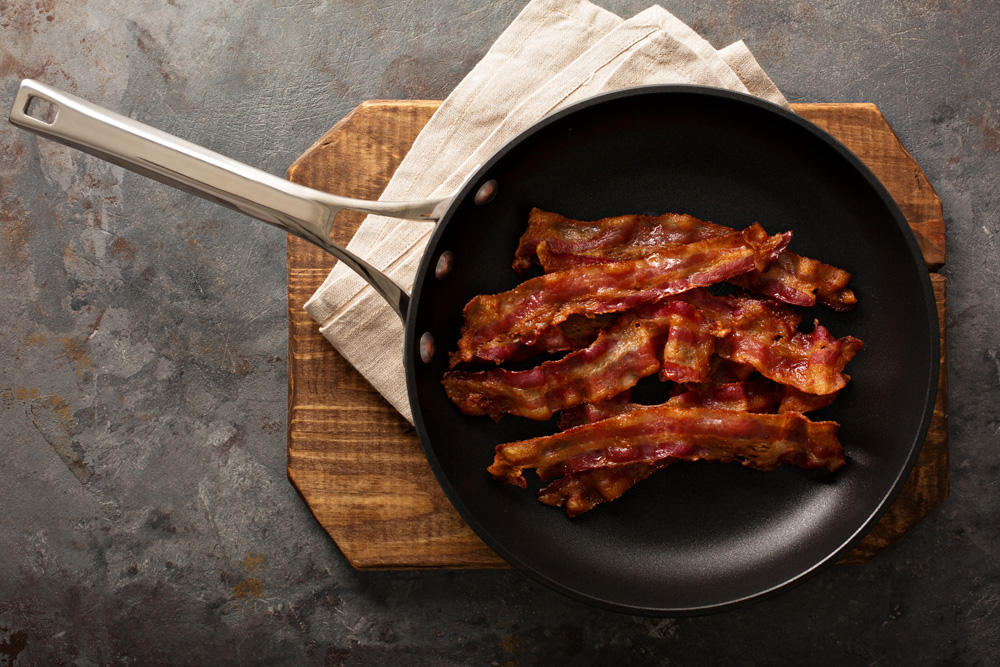The Manitoba Advantage in Pork Protein
Manitoba has extensive expertise and infrastructure to support competitive pork production. Manitoba is home to numerous service companies that offer expertise and knowledge in herd management, animal health, and marketing.

Rural Manitoba has many locations where hog operations can be built and offer a good supply of locally grown grains. There is also demand for hog manure as a valuable fertilizer in these regions. The low density of pigs in most regions of the province helps to maintain biosecurity and the high health status of the provincial swine herd.
Barns, feed mills, and processing facilities are being expanded, emphasizing sustainability, animal welfare, food safety, and quality. Farms can also take advantage of low-cost, sustainably produced hydroelectricity. Moreover, bacon produced in Manitoba is a premium product because the barley-based diet fed on prairie farms results in bacon with a firmer, white fat compared to the soft, orange-coloured fat produced when corn diets are provided.
Manitoba's Pork Industry
With more than 8.2 million hogs and pigs sold in 2022, Manitoba took the highest position in Canada for pork production.
- On July 1, 2022, there were 540 hog farms reporting 3.3 million hogs and pigs. The breeding herd numbered 346,900 head.
- The average herd size of over 6,037 head per farm represents the largest-sized pig farms in Canada.
- The most common operation type for pork production is farrow-to-finish.
- In terms of agricultural cash revenues, the hog industry ranks third in Manitoba with $1.5 billion in 2022.
- Manitoba is Canada's top pig exporting province, accounting for 512 per cent of total national pig exports.
- Pig producers and brokers exported 3.1 million live animals to 11 countries in 2022, worth over $256 million.
- While 60 per cent of the hog is meat for consumption, the remaining components are utilized to generate value-added products like medications (e.g., insulin), gelatin, brushes, leather, and biofuel.
- Additionally, Manitoba produces wild boar and other specialty carcasses for markets that sell exotic meat.
Learn more about pork production in Manitoba here.
Manitoba’s Thriving Pork Sector
Economic contribution of primary hog production (direct and indirect output) was $2.9 billion in 2022. Manitoba farmers grow about 8 million pigs, of which 90% head for overseas markets as live animals or pork products. There is a cluster of primary production in Manitoba driving value-added processing and new investments. The plants in Neepawa and Brandon are prime examples.
- Since 2017, roughly $250 million in private equity has been invested in new barns or the restoration of existing facilities.
- Topigs Norsvin's $35 million investment in their nuclear facility in Plumas resulted in the creation of 35 permanent high-tech employment in rural Manitoba.
- The Maple Leaf's $250 million investment in Winnipeg's bacon production added 250 full-time permanent jobs that were previously exported to the United States. Over 2,000 employees are employed full-time at the Maple Leaf facility on Archibald and Marion.
- Hog production is closely linked to plant-protein processing. For example, In Portage la Prairie, by-products from Roquette are used as hog feed.
- The hog industry directly employs almost 14,000 Manitobans.
- Every $1 million generated by hog production can support up to nine jobs.
Industry Associations
Market and Consumer Trends
The Manitoba pork industry has extensive expertise and infrastructure to support competitive production. Many service companies are located in Manitoba and there are export opportunities for pork, particularly in Asian markets. Furthermore, new trade agreements, such as the Comprehensive and Progressive for Trans-Pacific Partnership, provide strong market access.
Research
The University of Manitoba and its Glenlea Research Station have swine-research facilities.
Researchers at the university have extensive publications in the field of swine nutrition, including antibiotic alternatives, feed enzymes, evaluation of feed ingredients, and digestive physiology. Numerous research initiatives have focused on the impacts of pig housing and management on productivity and animal welfare.
The Glenlea Research Station is home to the Bruce D. Campbell Farm and Food Discovery Centre. The centre demonstrates how food is raised from the farm to the kitchen plate. A viewing area for visitors exhibits a day in the life of a pig.
Contact
For more information about Manitoba's pork sector or if you would like this information in an alternate format, email us at: agindustrydev@gov.mb.ca
